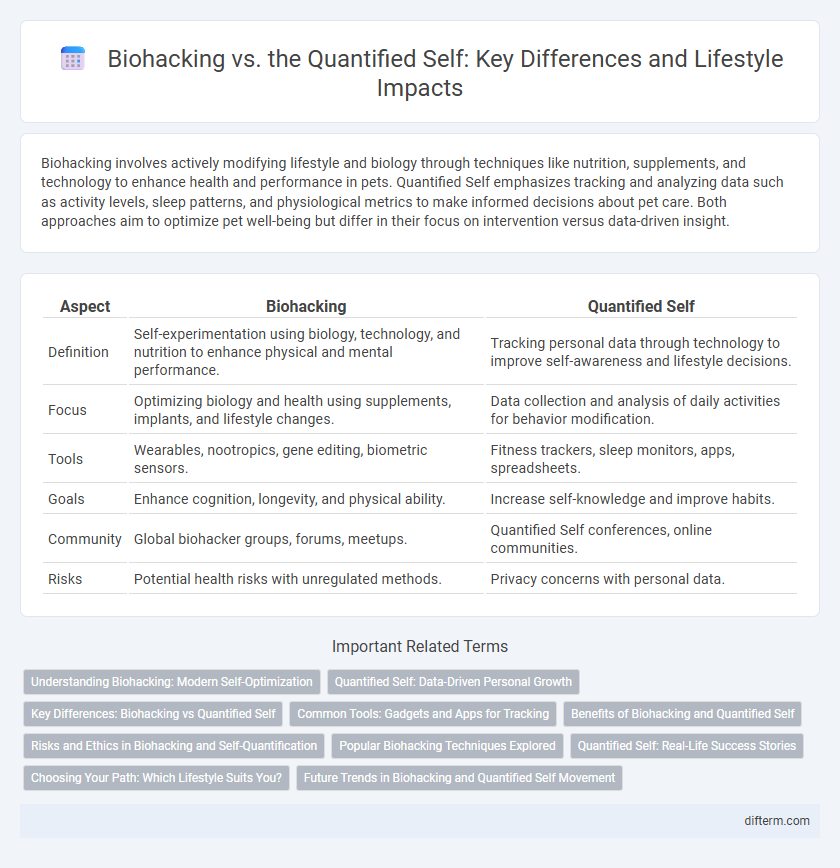Biohacking involves actively modifying lifestyle and biology through techniques like nutrition, supplements, and technology to enhance health and performance in pets. Quantified Self emphasizes tracking and analyzing data such as activity levels, sleep patterns, and physiological metrics to make informed decisions about pet care. Both approaches aim to optimize pet well-being but differ in their focus on intervention versus data-driven insight.
Table of Comparison
| Aspect | Biohacking | Quantified Self |
|---|---|---|
| Definition | Self-experimentation using biology, technology, and nutrition to enhance physical and mental performance. | Tracking personal data through technology to improve self-awareness and lifestyle decisions. |
| Focus | Optimizing biology and health using supplements, implants, and lifestyle changes. | Data collection and analysis of daily activities for behavior modification. |
| Tools | Wearables, nootropics, gene editing, biometric sensors. | Fitness trackers, sleep monitors, apps, spreadsheets. |
| Goals | Enhance cognition, longevity, and physical ability. | Increase self-knowledge and improve habits. |
| Community | Global biohacker groups, forums, meetups. | Quantified Self conferences, online communities. |
| Risks | Potential health risks with unregulated methods. | Privacy concerns with personal data. |
Understanding Biohacking: Modern Self-Optimization
Biohacking involves using science, technology, and personal experimentation to enhance physical and mental performance through tailored lifestyle changes, supplements, and wearable devices. Quantified Self focuses on systematic data collection and analysis of biological and behavioral metrics to inform decision-making for health improvements. Both approaches emphasize self-optimization but differ in methodology, with biohacking integrating experimental interventions and Quantified Self relying on continuous self-tracking.
Quantified Self: Data-Driven Personal Growth
Quantified Self emphasizes systematic tracking of biological, physical, and behavioral data to foster incremental personal growth through evidence-based adjustments. Wearable technology and mobile apps collect metrics like sleep patterns, heart rate variability, and activity levels that inform decision making and lifestyle optimization. This data-driven approach enables precise self-awareness and continuous improvement tailored to individual physiology and habits.
Key Differences: Biohacking vs Quantified Self
Biohacking involves intentional lifestyle and biological modifications using experiments with nutrition, supplements, and technology to enhance physical and cognitive performance. The Quantified Self focuses on self-tracking through data collection and analysis of metrics like sleep, activity, and biometrics to understand and improve daily habits. While biohacking emphasizes proactive intervention, Quantified Self prioritizes observation and data-driven insights for incremental self-improvement.
Common Tools: Gadgets and Apps for Tracking
Biohacking and Quantified Self both emphasize self-optimization through technology, using gadgets like wearable fitness trackers, smartwatches, and continuous glucose monitors to gather real-time health data. Apps such as MyFitnessPal, Sleep Cycle, and Oura provide detailed analytics on nutrition, sleep quality, and daily activity, enhancing personalized lifestyle adjustments. These tools enable users to make informed decisions, improving physical performance and overall well-being.
Benefits of Biohacking and Quantified Self
Biohacking enhances personal health and performance by leveraging nutrition, technology, and behavioral changes to optimize physical and mental well-being. Quantified Self practices involve tracking biometric data and daily activities to gain insights and make data-driven decisions for lifestyle improvements. Both approaches empower individuals to achieve sustained health benefits through personalized, measurable interventions.
Risks and Ethics in Biohacking and Self-Quantification
Biohacking poses significant ethical concerns related to privacy, data security, and potential health risks due to unregulated modifications and experimentation. The quantified self movement raises issues surrounding data ownership, consent, and the accuracy of self-tracked biometric information, which can lead to misinformation and anxiety. Both practices require careful consideration of personal and societal impacts to navigate the balance between innovation and ethical responsibility.
Popular Biohacking Techniques Explored
Popular biohacking techniques include intermittent fasting, nootropic supplementation, and cold exposure therapy, which aim to enhance physical and cognitive performance. Quantified Self practices focus on systematic self-tracking using wearable devices and apps to gather data on sleep, activity, and biometrics for personalized health insights. Both approaches prioritize optimizing well-being through measurable lifestyle adjustments supported by emerging technologies.
Quantified Self: Real-Life Success Stories
Quantified Self enthusiasts leverage wearable technology and data analytics to optimize health, productivity, and mental wellness, with success stories showing significant improvements in sleep quality, stress management, and physical fitness. Real-life examples include individuals tracking biometric data to reverse chronic illnesses or enhance athletic performance, demonstrating the power of personalized data-driven interventions. These achievements underscore the practical benefits of self-quantification for long-term lifestyle enhancements.
Choosing Your Path: Which Lifestyle Suits You?
Biohacking emphasizes optimizing physical and mental performance through experiments with nutrition, supplements, and technology, appealing to those seeking radical self-improvement and cutting-edge bio-innovation. Quantified Self focuses on gathering and analyzing personal data like sleep patterns, heart rate, and activity levels to make informed lifestyle adjustments, ideal for individuals who prefer data-driven insights and gradual progress. Choosing between biohacking and Quantified Self depends on your comfort with experimental approaches versus steady, evidence-based tracking to enhance overall well-being.
Future Trends in Biohacking and Quantified Self Movement
Future trends in biohacking and quantified self movement emphasize advanced wearable technology and AI-driven health analytics, enabling real-time biomarker monitoring and personalized wellness plans. Integration of genomics and metabolomics data will accelerate precision health optimization, while neurofeedback devices and implantable sensors gain popularity for cognitive and physical enhancement. Increased collaboration between biotechnology startups and healthcare providers promises to transform preventive medicine and longevity strategies.
Biohacking vs Quantified Self Infographic

 difterm.com
difterm.com